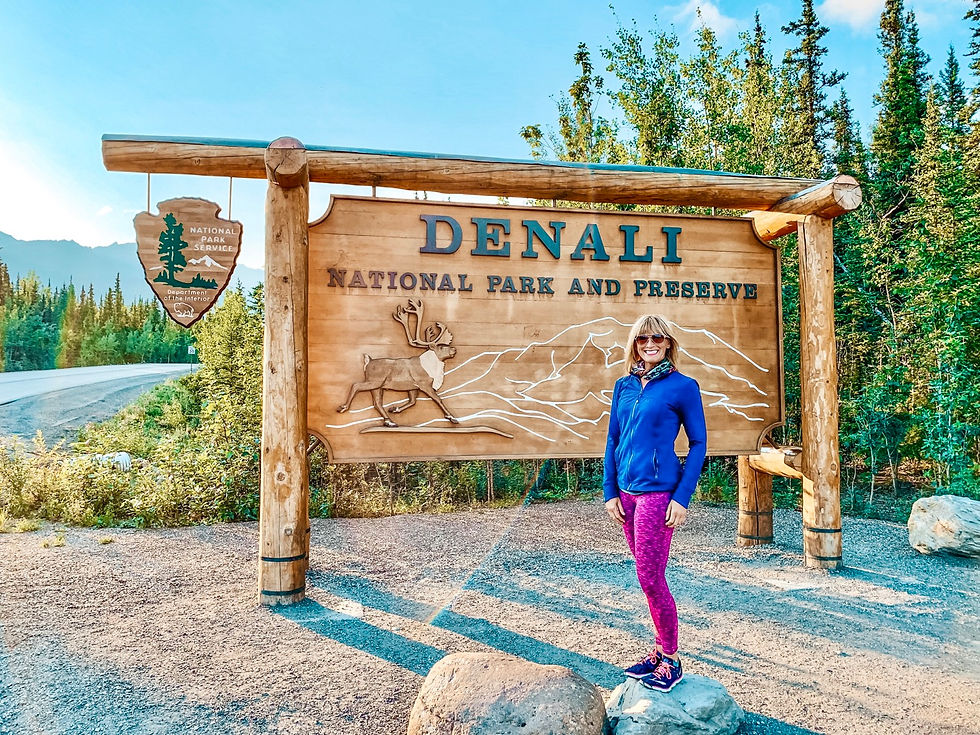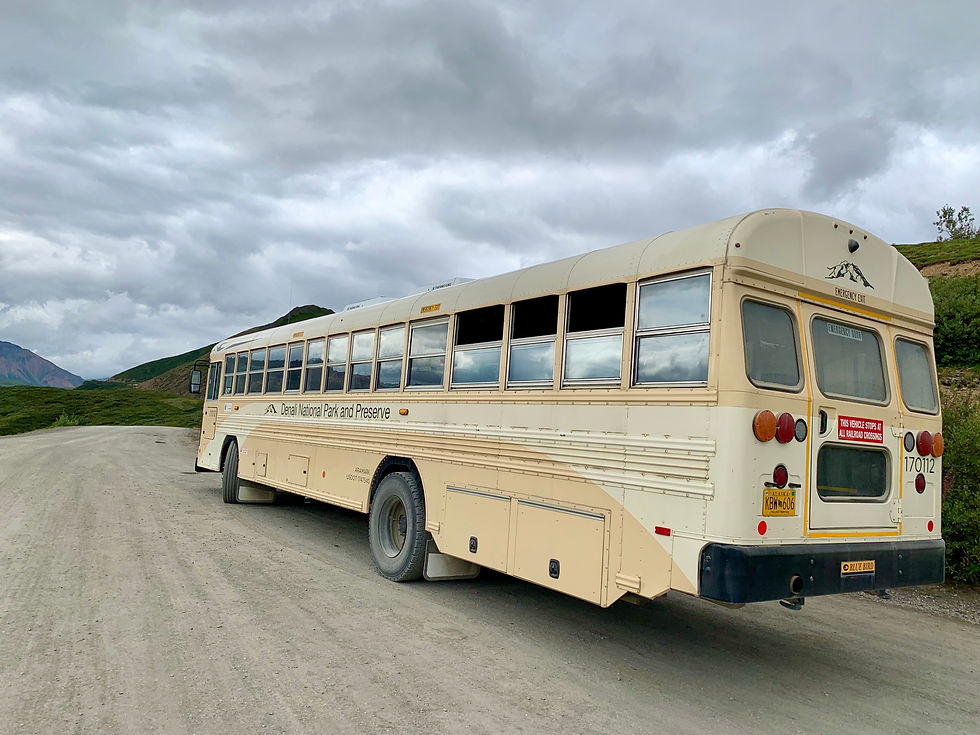
The top of my travel bucket list? ALASKA. This dream finally came true, as my mom and I embarked on a girl's trip across the US. Three airports, two planes and one flight delay later -- not to mention the 10 hours of travel time [and the several complimentary snacks we ingested - thanks, Delta!] -- we finally reached our destination. Was it worth it? Undeniably, yes.


DENALI NATIONAL PARK | ALASKA Once settled in Alaska, we decided to visit the state's most well-known national park: Denali National Park. Curious to see the amazing wildlife that occupied this part of the state, we could not wait to embark on an adventure to the heart of Alaska. Encompassing over 6 million acres, this park is located about 240 miles north of Anchorage and 125 miles south of Fairbanks. What better way to enjoy the scenic views into the park but by train -- so we excitedly bought tickets and boarded a dome-shaped train car called The Wilderness Express in Fairbanks, Alaska. The train ran along the Alaska Railroad Denali Star Route and would take us right into the park. Just when I thought the day trip couldn't get any better, the dining car below proudly announced they were serving pancakes. BEST. DAY. EVER. Buckled in and enjoying the view from my window-seat, I anxiously anticipated the entrance into this well-known park.

LET'S START WITH THE FACTS: PARK’S FOUNDATION & MOUNT DENALI
In 1912, Charles Sheldon was captivated with this park’s beauty and began working to create the legislation for this park. In 1917, after 9 years of Sheldon’s efforts, it became known as the first official national park in Alaska. Originally, this park was named Mount McKinley Park - named for the 20,320 foot mountain that heralded visitors to this land. William Dickey, a man searching for gold along the interior of Alaska, named the mountain 'McKinley' due to his favor or President McKinley. Great tribute, huh?
In 1980, the Alaska National Interest Lands Conservation Act (ANILCA) enlarged the boundaries of the park by four million acres. They re-grouped the land to create the Denali National Park and Preserve. Encompassing over 6 million acres, crazy enough -- this national park is larger than the state of New Jersey! This Midwest gal found this fact baffling, as it made me realize that although I experienced a full 2-3 days within the park, I only got to see a small portion of Denali. This park is massive!
On the park’s 100th anniversary, the name of the park was changed to Denali National Park in favor of the native Athabaskan people who first belonged to this part of Alaska. Denali is known as ‘the Great One’ — true to the old Athabaskan name. The name of the mountain continued to be known as Mount McKinley in favor of the late president, but it was then changed to Denali in 2015 to reflect it’s great status and heritage.
FACT: Mount Denali is the largest mountain in North America. Most days, the peak of Denali is very difficult to see, as the clouds cover the top of the mountain. Imagine this: although this mountain is massive in size, Denali would not even rank in the top one-hundred mountains of the Himalaya range! Did you know: Asia and South America are the only two continents that have a mountain larger than Mount Denali. It is no surprise that Mount Denali is the heart of Denali National Park, as it truly is the highlight [and heartbeat] of the entire area. Unfortunately Mount Denali was mostly covered in fog for the majority of time I was in the park. Alaska was experiencing some wildfires that caused the visibility to be affected. I did get a few glimpses of this massive structure, as a couple within my tour group took an airplane ride to the top of the mountain. Their pictures turned out amazing. What a sight!

ROAD THROUGH DENALI In 1938, a 92-mile road was completed that allowed visitors to travel through the park. Beginning in 1923, rock was blasted to create a road that wound from the park’s entrance to the west toward Kantishna, Alaska. The road begins with a modern two-lane road for the first 15 miles near the entrance of the park. It changes to a gravel road from mile 15 to 31. For the last 60 miles from mile 32 to 92, it is a one-lane gravel road. Did you catch that? A one-lane gravel road that curves through the mountains for large tour buses to take tourists through the park. Trust me -- the bus ride itself is an adventure! FACT: In 1972, a park regulation was put in place to restrict private vehicle travel beyond the Savage River. This regulation also instituted a public transportation system. This regulation also set a limit of how many visitors would use this road. Since Denali National Park covers more than 6 million acres, this road is the main way to access or see various parts of the park. This single road after mile 32 was designed to preserve the character of the wilderness and to allow for the movement of wildlife in a natural setting This road was blasted from rock and routed over passes to allow travelers to view massive landscapes that were unmarred by the presence of the road itself. FACT: The road was nominated to the National Register of Historic Places in 2013.

CLIMATE
The annual precipitation in the park is about 15 inches a year. In 1933, the park received the highest snowfall in one day, as it snowed 33 inches within 24 hours. Ready for some more trivia facts? The most recorded snow on the park’s ground was 56 inches in 1991. On average, the temperature is just above freezing at 38 degrees Fahrenheit; however, the lowest temperature in the park reached -55 degrees Fahrenheit in 1999. The highest temperature ever recorded within the park was 91 degrees Fahrenheit in 1991.
There are actually two distinct climates within the park. Both climates differ in types of vegetation and landscape features. On the south side of the Alaskan Range, the climate is influenced by the Gulf of Alaska with mild temperatures, less seasonal variation and more precipitation. The northern side of the park consists of the warm summers and cold winters, as it boasts characteristics of an interior climate.

I visited the park at the beginning of August, and I was surprisingly in shorts! At the time, Alaska was experiencing a heat wave, so I welcomed the opportunity to not have to bundle up. The temperature ranged in the 50s, but it was a very dry 55 degrees. My tour group did not experience any rain while we were in the park; however, we had some friends that visited the park a few weeks after us, and it rained the entire time they were there. In the evenings and early mornings, it did get a bit chilly. We were prepared with winter coats, just in case, as we knew the temperature could fluctuate from one day to the next.
VEGETATION & LANDSCAPE
Believe it or not, Denali National Park is home to over 1,500 species of plants. These plants form the foundation of the park’s ecosystem. These plants also provide a strong vegetation food source to the many wildlife that inhabit this region. The park can be divided into three layers: the lowlands, the sub-alpine, and the alpine.
The lowlands occupy 0 to 650 meters and consist of predominantly forest. This part of the park contains black and white spruce trees to birch trees that are underlain by permafrost.
The sub-alpine is between 650 and 950 meters and consists more of vegetation, spruce woodland, and meadows.
It is within the alpine section of the park that consists of anything above 950 meters that the majority of plant diversity exists. In fact, in this section, there are high numbers of rare species including several types of willow trees and green alder trees.
One of the most interesting characteristics of Denali National Park is the layer of permafrost that inhabits most of this region. Permafrost is a thick layer of soil that remains frozen throughout the year.
FACT: it is any part of the ground that remains completely frozen for at least two years straight. Thawing permafrost can have large affects on this region, as it can destroy roads or any infrastructure built on permafrost. Permafrost can be in areas that are not covered by snow, as it is a combination of rocks, soil, sand held by ice.
ANIMALS Although the park rotates around the snow-covered top of Mount Denali, the landscape varies from forests to tundras to rivers and glaciers and to the amazing wildlife that roams this plot of land. In fact, the wildlife is the highlight of Denali National Park. This park is home to wildlife of all sorts—bears, moose, caribou, Dall sheep, gray wolves, and bald eagles, to name a few. How inspiring to know that Denali was the first national park created to protect wildlife. Due to the efforts to preserve the creatures of this park, it is now home to 39 species of mammals, 169 species of birds, and 1 specie of amphibian [wanna guess? yep, a frog - the Alaskan Wood Frog!]. One of the major goals of the many visitors who adventure to this park (including yours truly!) is to see the extensive wildlife. The park is known for it’s ‘Big Five’: moose, caribou, Dall sheep, wolves, and grizzly bears.

<<check out this super-cool photo of a Dall sheep! My tour guide snapped this picture with his snazzy camera!>> You can find creatures big and small throughout the park, as the park has a wide array of mammals that are exciting to watch. If you visit the park during the winter months, you may see a snowshoe hare hiding among the snow. You may even see a wolverine searching for his next meal! Of course, visitors need to be cautious as they are traveling through the park, as some of the wildlife can be very dangerous.

WHY YOU SHOULD VISIT: ADVENTURE REALLY IS HERE!
Denali National Park is breathtaking. Not only is the highest mountain recorded in North America located here, the wildlife is unbelievable. This sub-artic ecosystem is filled with large mammals that anyone would love to see in their natural habitat. I was most surprised by green shrubbery on the ground floor of the park highlighted by the snow-capped mountains in the distance. It made every place in this park a picturesque spot.
You couldn't turn a corner in the park without catching one breathtaking view after another. It really helped put life into perspective. Fresh air is so good for the soul.
There were lots of opportunities for adventure during our stay within the park! You need to add Alaska and Denali National Park to your bucket list. What a trip of a lifetime! Get outside & explore -- I promise you won't be disappointed.


























